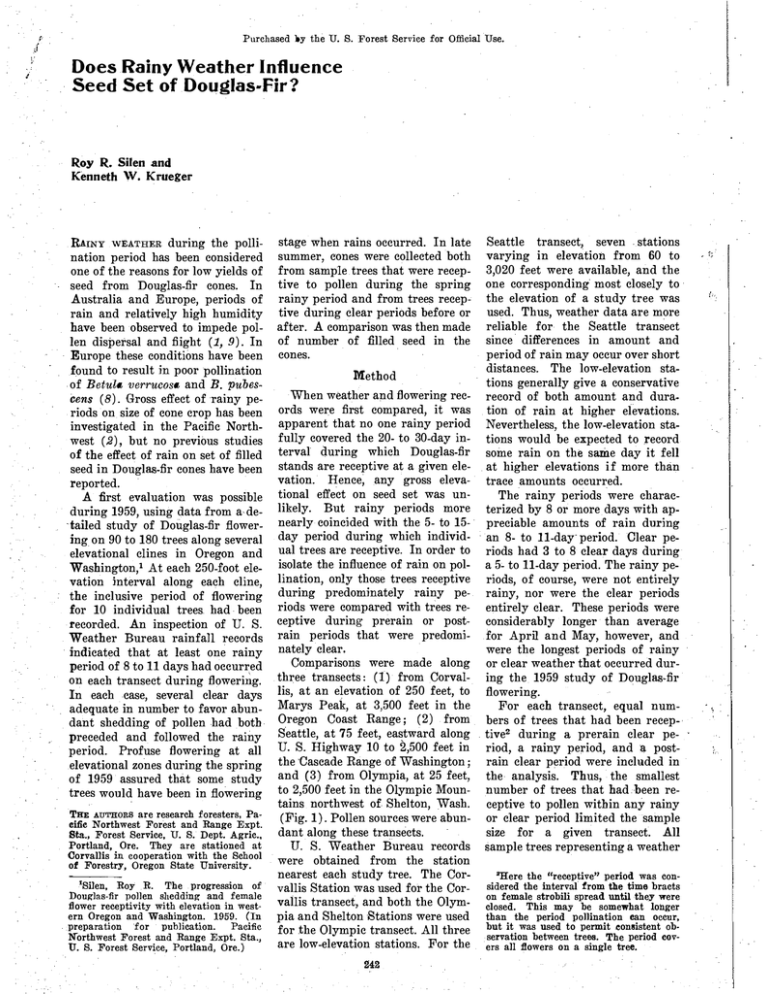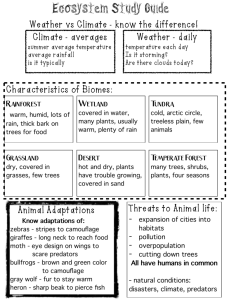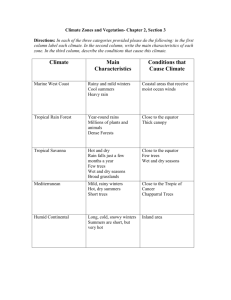Document 12787066
advertisement

OF FORESTRY, \lol. 60, No. 4, April 1962 Purchased by the U. S. Forest Service for Official Use. Repritnted fro1n the JOURNAL J " . Does Rainy Weather Influence Seed Set of Douglas-Fir? R.oy R.. Silen and Kenneth W. K rueger RAINY WEATHER during the polli­ nation period has been considered one of the reasons for low yields of seed from Douglas-fir cones. In Australia and Europe, periods of rain and relatively high humidity have been observed to impede pol­ len dispersal and flight (1, 9). In Europe these conditions have been found to result in poor pollination of Betula verrucosa and B. pubes­ cens (8). Gross effect of rainy pe­ riods on size of cone crop has been investigated in the Pacific North­ west (2), but no previous studies of the effect of rain on set of filled seed in Douglas-fir cones have been reported. A first evaluation was possible during 1959, using data from a· de­ tailed study of Douglas-fir flower­ ing on 90 to 180 trees along several elevational clines in Oregon and Washington,' At each 250-foot ele­ vation interval along each cline, the inclusive period of flowering for 10 individual trees. had been recorded. An inspection of U. S. Weather Bureau rainfall records indicated that at least one rainy period of 8 to 11 days had occurred on each transect during floweri g. In each case, several clear days adequate in number to favor abun­ dant shedding of pollen had both preceded and followed the rainy period. Profuse elevational zones of 1959 assured trees would have flowering at all during the spring that some study been in flowering THE AUTHORS are research foresters, Pa cifie Northwest Forest and Range Expt. Sta., Forest Service, U. S. Dept. Agric., Portland, Ore. They are stationed at Corvallis in cooperation with the School of Forestry, Oregon State University. 1Silen, Roy R. The progression of Douglas-fir pollen shedding and female flower receptivity with elevation in west­ ern Oregon and Washington. 1959. (In preparation for publication. Pacific Northwest Forest and Range Expt. Sta., U. S. Forest Service, Portland, Ore.) Seattle transect, seven stations varying in elevation from 60 to 3,020 feet were available, and the stage when rains occurred. In late summer, cones were collected both from sample trees that were recep­ tive to pollen during the spring one corresponding most closely to the elevation of a study tree was used. Thus, weather data are more reliable for· the Seattle transect since differences in amount and rainy period and from trees recep­ tive during clear periods before or after. A comparison was then made of number of filled seed in the cones. period of rain may occur over short distances. The low-elevation sta­ Method tions generally give a conservative record of both amount and dura­ tion of rain at higher elevations. Nevertheless, the low-elevation sta­ When weather and flowering rec­ ords were first compared, it was apparent that no one rainy period fully covered the 20- to 30-day in­ terval during which Douglas-fir stands are receptive at a given ele­ vation. Hence, any gross eleva­ tional effect on seed set was un­ likely. But rainy periods more nearly coincided with the 5- to 15­ day period during which individ­ ual trees are receptive. In order to isolate the influence of rain on pol­ lination, only those trees receptive during predominately rainy pe­ riods were compared with trees re­ ceptive during· prerain or post­ rain periods that were predomi­ nately clear. Comparisons were made along three transects: (1) from Corval­ lis, at an elevation of 250 feet, to Marys Peak, at 3,500 feet in the Oregon Coast Range ; ( 2) from Seattle, at 75 feet, eastward along U. S. Highway 10 to 2,500 feet in the Cascade Range of Washington; and (3) from Olympia, at 25 feet, to 2,500 feet in the Olympic Moun­ tains northwest of Shelton, Wash. (Fig. 1). Pollen sources were abun­ dant along these transects. U. S. Weather Bureau records were obtained from the station nearest each study tree. The Cor­ vallis Station was used for the Cor­ vallis transect, and both the Olym­ pia and Shelton Stations were used for the Olympic transect. All three are low-elevation stations. For the 242 tions would he expected to .record some rain on the same day it fell at higher elevations i f more than trace amounts occurred. The rainy periods were charac­ terized hy 8 or more days with ap­ preciable amounts of rain during · an 8- to 11-day period. Clear pe­ riods had 3 to 8 clear days during a 5- to 11-day period. The rainy pe­ riods, of course, were not entirely rainy, nor were the clear periods entirely clear. These periods were considerably longer than average for April and May, however, and were the longest periods of rainy or clear weather that occurred dur­ ing the 1959 study of Douglas-fir flowering. For each transect, equal num­ bers of trees that had been recep­ tive2 during a prerain clear pe­ riod, a rainy period, and a post­ rain clear period were included in the analysis. Thus, the smallest number of trees that had been re­ ceptive to pollen within any rainy or clear period limited the sample size for a given transect. All Sample trees representing a weather 2Here the "receptive" period was con­ sidered the interval from the time bracts on female strobili spread until they were closed. This may be somewhat longer than the period pollination can occur, but it was used to permit eonsistent ob­ servation between trees. The period cov­ ers all flowers on a single tree. , ,, ,APRIL 1962 243 . ' period on a particular transect are located within a 500-foot eleva­ tion.al range, and most sample groups are within a 250-foot zone. Fully developed· cones were col­ lected from several parts of the crown of each sample tree. From among these, 10 insect-free cones were selected for cutting tests of seeds in the central two-thirds of each cone. Seeds were classified into three categories: (1) filled, (2) normal in size and appearance but empty save for the dry, shriv­ eled remains of the female gameto­ phyte, and (3) flat and undevel­ oped, 'voody in appearance, and often containing a pitchy sub­ stance. Seeds in each cOne were WEATHER STATIONS Seattle Snoqualmie Falls ELEVATION so' 4401 Landsburg 5301 Palmer 9001 Cedar Lake Snoquolmie Poss 1,5601 3,0201 Olym pi a 100' ' 40 Corvallis 200' Shelton examined until the combined num­ ber in classes 1 and 2 totaled 25. Seeds in class 3 were not used in the analysis since they are consid­ - . -- - -· ered incapable of normal develop­ ment.3 Preliminary observations had shown that a percentage based on this sample size is representa­ tive of all seeds in the central part Of a one. Filled seeds were assumed to in­ dicate pollination, and the no'rmaf­ appearing but empty seeds to indi­ cate nonpollination. This assump­ tion may involve two small errors. First, filled seed may possibly arise by apomixis. The occurrence of 22 filled seeds in 11 unpollinated eones has been reported on a sin­ gle tree ( 6). If this proportion holds true generally, our cutting tests would introduce a positive error of about 8 percent. The like­ lihood of such a high error on sev­ eral trees is believed small, how­ ever. Second, self"pollination may pro­ duce ·aborted ovules (5) which we would have classed as unpollinated. Although aborted ovules may be a source of variability in this study, they should not bias percentage of filled seed of samples pollinated during rainy or clear periods. In­ dividual trees are highly variable in both respects (5, 6) . Percentage of filled seed was cal­ culated for each of 10 cones from a sample tree. Differences in per­ 8This procedure was adopted after con­ 1:1ultation with Dr. A. L. Orr-Ewing and Dr. T. M. Ching, tree seed authorities for Douglas-fir. Such· seed may corre· spond· to the "aborted" ovules described by Lyons (4) for Pinus resi1n.osa. FIG. 1.-Location of transects and weather stations. centage of filled seed between trees receptive to pollination during rainy and clear periods were then analyzed. Variation among indi­ vidual trees receptive during the same period was also studied. Rainy Weather and Pollination Evidence from this analysis does not lend much support to the the­ ory that rainy weather inhibits pollination of Douglas-fir. Aver­ age percentage of filled seed for rainy-period receptivity was sig­ nificantly less (5-percent level) than for clear-period receptivity only on the Corvallis transect. In this transect, the difference be­ tween rain and prerain periods averaged 13 percent; between rain and postrain periods, 18 percent (Table 1) . On the Seattle and Olympia transects, differences be­ tween rainy and clear periods were too small ( 0 to 11 percent) to provide statistical significance. As shown in Table 1, intensity and duration of rainfall were much greater on the Olympia and Seattle transects during rainy-period re. ceptivity than on the Corvallis transect. Thus, if rainy weather is a major factor affecting pollina­ tion, differences in _percentage of filled seed should have been more pronounced on the Washington transects. seed data any that A study of the filled­ records and related rainfall (Table 1) fails to bring out clear-cut failures in seed set can be attributed to rain. Variation Among Individual Trees Striking differences in percent­ age of filled seed for both rainy­ and · clear-weather periods were found among individual trees on all transects. Analyses of these dif­ ferences showed they are consis­ tently highly significant (1-per­ cent level) within each weather period on all three transects. Two trees on the Seattle tran­ sect furnish a striking example of between-tree variation. Located at a 2,200-foot elevation, the trees are growing side by side (with 244 JOURNAL OF FORESTRY TABLE 1.-RAINFALL DURING POLLINATION PERIOD ,AND PERCENT OF FILLED SEED FOR DOUGLAS-FIR TREES ON THREE TRANSECTS Item Corvallis transect Seat le transect PrePost- PrePostrain Rain rain _rain Rain rain Basis (number of trees) Average receptive period· per tree (days) Average number of rainy days during receptive period (percent) Average rainfall during recep- tive period (inches) Average.number filled seed (percent) Olympia transect PostPrerain Rain rain 10 10 10 6 6 6 5 5 5 10 10 11 11 11 5 8 8 10 20 80 45 36 91 40 25 100 40 1.2 0.1 73 60 1.21 78 0.6 67 6.8 56 0.6 63 0.6 57 6.8 57 1.1 64 1 Although the same rainfall occurred in the rain and postrain periods at Corvallis' rain was concentrated in a much shorter span in the postrain period. branches interlacing) and have identical receptive periods. Cones in one were consistently low yield­ ing, averaging 57.5 percent filled seed. Cones of the other were con­ sistently high yielding, averaging 91.6 percent. The entire crop of 8 and 10 cones, respectively, was ex­ amined from each tree, eliminating any chance for sampling error. Occurrence of flat, undeveloped seeds (class 3) was also highly variable between individnal trees. Cones from most trees averaged from one to five class 3 seeds for every 25 class 1 and 2 seeds sam­ pled. Comparative fignres ranged from a low of zero to a high of 20 for occasional trees, however. When high or low numbers of class . -3 seeds were encountered, thiS trait was consistent for all cones fronl 'a tree. Discussion Two considerations have prime importance in a discussion of these results. First, Douglas-fir stands are receptive to pollen for a 20- to 30-day period at a given elevation. Second, for an individual tree the receptive period is reduced to only 5 to 15 days, and for a single flow­ er the receptive period may be much shorter. Thus, while persist­ ent rain might conceivably' affect some flowers or whole trees, rains prolonged enough to preclude pol­ lination over a whole elevational zone would be a very rare occur­ rence. Although the trees nsed in this study were carefully selected to match receptivity with a predomi­ nately rainy or clear period, a measurable reduction in· percent­ age of filled seed occurred only on the Corvallis transect. Almost 7 inches of rain fell during the rainy period on the Seattle and Olympia transects, bli_t- trees receptive dur­ ing this period did not show a sig­ nificantly lower percentage of filled seed. Effective pollination appar­ ently occurred on most trees with­ out relation to amount and dura­ tion of rain. PresUmably, pollina­ tion can take place during even brief clearing. This preliminary study thus indicates that rainy weather does not seriously reduce seed set of Douglas-fir. For practical seed collection pur­ poses, any small adverse effect from rain during pollination could be more than offset by deliberately collecting seed from trees that dis­ play a high count of filled seed per coile. Such trees were found ·among .particular tree year after year. This study indicates that al­ though rainy periods may in some circumstances be related to re. duced seed set of Douglas-fir, other unmeasured factors probably exert an even greater influence. - One -of these is apparently the very large variation in seed set from tree to tree, which may be a heritable · trait. A renewed effort should be made to uncover the causes_ of this variation. Summary of Results. A preliminary study during 1959 indicates that rain during pollina' could not cause a ma­ tion period jor reduction in Douglas-fir seed set over a broad elevational zone. Rainy periods did not exceed 11 days on the three transects studied. In contrast, trees at a give11 eleva tion were receptive to pollen over a 20- to 30-day period. A study of individual trees that were recep­ tive to pollen during predominate­ ly rainy periods showed little re­ bility in seed set among individual trees may be physiological. The capacity for fertilization in spruce has been found to be genetically in­ fluenced ( 7) and percentage of hollow pine seed in Switzerland has likewise been found to be· a herit­ able trait (3); Both investigators stressed the importance of select­ ing good seedbearers, especially when collecting for breeding. pur­ poses. -'· Very low percentages of filled seed cir very high proportions of small, fiat, undeveloped seed, as ob­ served ill this study, may both be heritable characteristics. Thus, in . choosing parental stock fOr.· . see(! orchards, trees' with these traits · should usually be rejected, partfo­ ularly if the trait is observed on Jt · duction in filled seed per cone when compared with trees receptive dur­ ing clear periods. Variations in seed set among individual trees were large, however, for . both clear and rainy periods, indicating that unmeasured factors were mainly responsible. all pollination periods sampled without regard to weather during pollination. Many professional tree seed collectors have followed this practice. for years. At least part of the great varia­ -i Literature Cited 1. FIELDING, J. M. 1957. Notes on the dispersal of pollen by Monterey pine. Austral. Forestry 21(1) :17-22. 2. GARMAN, E. R. 1955. Regeneration problems and their silvicultural sig. nificance in the coastal forests ot British Columbia. Brit. Columbia For· est Serv. Tech. Pub. 41. 67 pp. Illus. 3. KARSCHON, R. 1950. Uber den Hohl· kornanteil bei FOhrensaatgut autoch thoner Populationen. (A b s t r a c t} Schweiz. Z. Forstw. 101(6) :295-296. 4. LYONS, L. A. 1956. The seed capac­ ity and efficiency of red pine cones. (Pinus resinosa). Canad. Jour. Bot. 34(1) '27·36. Illus. 5. ORR-EWING, A. L. 1954. Inbreeding­ eiperiments with the Douglas :fir. Forestry Chron. 30(1) :7-16. Illus. 6. . 1957. Possible occur­ rence of viable unfertilized seed 'in Douglas-fir. Forest Sci. 3(3) :243248. Ilfus. 7. ROHMEDER, E. 1954, Un\velt unct - Erbanlagen bei der Fichtensamenaus· beute. Z. Forstgenet. 3(6) :113-118. 8. SARVAS, RISTO. 1956. Investigations into the :flowering and seed quality of forest trees. Commun. Inst. for Fenn. 45(7 , ) ,1.37. Illus. 9. ScAMONI, A. 1955. Boebachtungen iiber den Pollenfiug der· Wiildbaum& .J.J-: in Eberswalde . .Z. Forstgenet. 4(4/5) 113-122..




